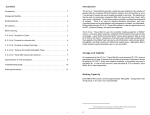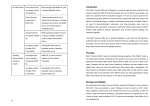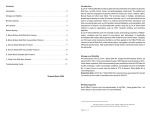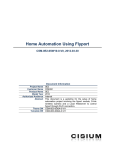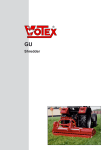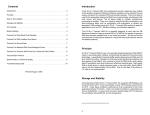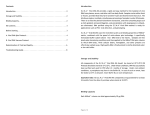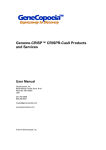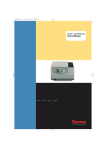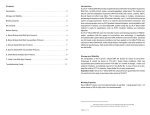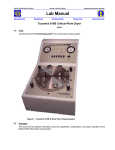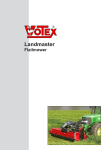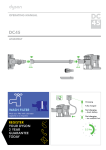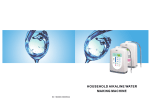Download Forensic DNA mini-prep
Transcript
Contents Introduction . . . . . . . . . . . . . . . . . . . . . . . . . . . . . . . . . . . . . . . . . . . . 2 Principle . . . . . . . . . . . . . . . . . . . . . . . . . . . . . . . . . . . . . . . . . . . . . . 2 New in this addition . . . . . . . . . . . . . . . . . . . . . . . . . . . . . . . . . . . . . . 2 Storage and Stability . . . . . . . . . . . . . . . . . . . . . . . . . . . . . . . . . . . . . 3 Kit Contents . . . . . . . . . . . . . . . . . . . . . . . . . . . . . . . . . . . . . . . . . . . . 3 Before Starting . . . . . . . . . . . . . . . . . . . . . . . . . . . . . . . . . . . . . . . . . 4 Protocol for Dry blood samples . . . . . . . . . . . . . . . . . . . . . . . . . . . . . 4 Protocol for Sperm . . . . . . . . . . . . . . . . . . . . . . . . . . . . . . . . . . . . . . 5 Introduction E.Z.N.A.® Forensic DNA Extraction Kit combines Omega Bio-tek’s innovative OB Specimen Collection Paper with time tested E.Z.N.A.® Blood DNA kit to provide a rapid and easy method for the isolation of genomic DNA from forensic sample such as dry blood and sperm for consistent PCR and Southern analysis. This kit can also be used for preparation of genomic DNA from mouse tail snips, blood, buffy coat, serum, and plasma. The kit allows single or multiple, simultaneous processing of samples. There is no need for phenol/chloroform extractions, and time-consuming steps such as precipitation with isopropanol or ethanol, are eliminated. DNA purified using the E.Z.N.A.® Forensic DNA method is ready for applications such as PCR*, Southern blotting, and restriction digestion. The E.Z.N.A.® Forensic DNA Extraction Kit is specially designed for isolation of genomic DNA from forensic sample such as dry blood and sperm. Since this kit is modified from the E.Z.N.A.® Tissue DNA kit, so it can also used for fress or frozen tissue samples, mouse tail snips. Protocol for buccal swabs . . . . . . . . . . . . . . . . . . . . . . . . . . . . . . . . . 7 Protocol for bacterial DNA from body fluids . . . . . . . . . . . . . . . . . . . . 8 Principle Vacuum/Spin protocol . . . . . . . . . . . . . . . . . . . . . . . . . . . . . . . . . . . . 9 E.Z.N.A.® forensic DNA Extraction Kits use the reversible binding properties of HiBind® matrix, a new silica-based material, combined with the speed of mini-column spin technology. A specifically formulated buffer system allows Genomic DNA up to 60 kb to bind to the matrix. Samples are first lysed under denaturing conditions and then applied to the HiBind® spin columns to which DNA binds, while cellular debris, hemoglobin, and other proteins are effectively washed away. High quality DNA is finally eluted in sterile deionized water or low salt buffer. Each HiBind®column can bind approximately 100 :g DNA. Using greater than 30 mg tissue or 107 cells is not recommended. Determination of Yield and Quality . . . . . . . . . . . . . . . . . . . . . . . . . . 9 Troubleshooting Guide . . . . . . . . . . . . . . . . . . . . . . . . . . . . . . . . . . 10 Ordering Information . . . . . . . . . . . . . . . . . . . . . . . . . . . . . . . . . . . . 12 New in this edition ! New capped V-Spin column ensures the elimination of potential contamination during operation. ! Optional vacuum-spin (for V-Spin column) protocol include. ! New protocols are available for sperm, buccal swabs and bacterials. * The PCR process is covered by U.S. Patents 4,683,195 and 4,683,202 (and international equivalents) owned by Hoffmann-LaRoche, Inc. 2 Before Starting Storage and Stability IMPORTANT All components of the E.Z.N.A.® Forensic DNA Extraction Kit, except the OB Protease can be stored at 22oC-25oC. Once reconstituted in water, OB Protease must be stored at -20oC. Under these conditions, DNA has successfully been purified and used for PCR after 24 months of storage. Under cool ambient conditions, a precipitate may form in the Buffer BL. In case of such an event, heat the bottle at 37oC to dissolve. Store Buffer BL at room temperature. See expiration date on box. Kit Contents 1 Reconstitute OB Protease in 150 :l (Trial Kit) or 1.5 ml (50 and 200 preps) 10 mM Tris-HCl, pH 8. Vortex vial briefly prior to use. 2 Wash Buffer Concentrate must be diluted with absolute ethanol as follows: D3592-00 Add 18 ml ethanol D3592-01 Add 36 ml ethanol / bottle D3592-02 Add 60 ml ethanol / bottle All centrifugation steps must be performed at room temperature. Product D3592-00 Trial Sample D3592-01 50 Preps D3592-02 200 Preps HiBind® DNA columns 5 50 200 2 ml Collection Tubes 15 150 600 Buffer BL 5 ml 20 ml 60 ml Buffer TL 5 ml 20 ml 50 ml Wash Buffer Concentrate 12 ml 2 x 24 ml 3 x 40 ml Elution Buffer 2 ml 30 ml 2 x 50 ml OB Protease 3 mg 30 mg 4 x 30 mg OB Specimen Collection Paper 5 Packs 50 Packs 200 Packs User Manual 1 1 1 Components Standard Forensic DNA Protocol Isolate DNA from Dried Blood , body fluid, Sperm Spots Dried blood , body fluid, Sperm samples on filter paper can be processed using the following method. We recommend using OB Specimen Paper (OBP-01 and OBP-02) for spotting blood as this unique filter paper disintegrates when incubated in aqueous buffers and allows efficient recovery of DNA. This kit can also be used for samples collected by using other specimen collection paper. Note: E.Z.N.A.® Forensic DNA Extraction Kit supplied enough buffer for standard protocol. However, due to increased volume for some protocols (Such as buccal swab protocol), fewer preparation will be preformed. Additional buffers can be purchased separately from Omega Bio-tek. See accessories in catalog or call customer service for price information . Buffer BL contains a chaotropic salt. Use gloves and protective eyeware when handling this solution. 3 1. Cut or punch out the blood (or other sampl) spot from the filter paper. (Up to 200 :l blood can be used for each spot.) Tear or cut filter into small pieces and place into a microfuge tube. Note: use 3-4 punched cycles (3mm diameter) for each DNA isolation. 2. Add 200 :l Buffer TL and incubate at 55oC for 15 minutes. Vortex to mix every 2 min. 3. Add 25 :l OB protease solution and mix by votexing. Incubate 45 min at 60oC with occasional mixing. Brief centrifuge to remove the drop from inside the lid. 4. Add 225 :l Buffer BL and votex to mix. Incubate at 60oC for 10 minutes. Brief centrifuge to remove the drop from inside the lid. 5. Add 225 :l absolute ethanol and mix thoroughly by vortexing. 4 Brief centrifuge to remove the drop from inside the lid. 6. 7. 8. 9. 1% SDS Assemble HiBind® DNA mini column assembled in a 2 ml collecting tube (provided). Transfer the entire sample from step 5 into the column including any precipitate that may have formed. Centrifuge at 8,000 x g for 1 min to bind DNA. Discard the collection tube and flow-through liquid. 2% ß-mercaptoethanol 1. Add 50-250 :l of sperm to 10 ml of Buffer A in a glass (Corex) centrifuge tube. Vortex for 10 sec at full speed. Only use Corex tubes to prevent attachment of the sperm cells to the tube walls. 2. Centrifuge for 10 mm at 4,000 rpm (2500 x g). 3. Using a new collection tube, wash the column with a second 750 :l of Wash Buffer and centrifuge as above. Discard flow-through. Carefully remove the supernatant leaving ~ 1ml of pellet and Buffer A. 4. Using the same 2ml collection tube, centrifuge at maximum speed (10,000 x g) for 2 min to dry the column. This step is crucial for ensuring optimal elution in the following step. Vortex for 10 sec and centrifuge at full speed to collect any sample adhering to the walls of tubes. Transfer info a 2.0 ml microfuge tube 5. Add 0.5 ml of Buffer A to the Corex tube and vortex for 30 sec and centrifuge at full speed to collect any sample adhering to the walls of the tube. Transfer into the 2 ml microfuge tube. 6. Centrifuge for 2 mm at full speed in a microfuge. 7. Carefully remove the supernatant without disturbing the semen pellet. 8. Resuspend pellet in 300 :l of Buffer B. 9. Ada 100 :l Proteinase K or OB Proteinase (20 mg/ml) and incubate for 2 hours at 60oC. Place the column into a second 2 ml tube and wash by pipetting 750 :l of Wash Buffer diluted with ethanol. Centrifuge at 8,000 x g for 1 min. Again, dispose of collection tube and flow-through liquid. 10. Place the column into a sterile 1.5 ml microfuge tube and add 200 :l of preheated (70oC) Elution Buffer. Allow tubes to sit for 3 min at room temperature. 11. To elute DNA from the column, centrifuge at 8,000 x g for 1 min. Repeat the elution with a second 200 :l of Elution Buffer. Incubation at 70oC rather than at room temperature will give a modest increase in DNA yield per elution. Alternatively the second elution may be performed to increase the DNA yield. Blood spots from finger pricks usually contain no more than 50 :l blood and yield approximately 500 ng to 1 :g DNA. This is sufficient for PCR analysis. To obtain higher DNA concentrations, elute with 50 :l preheated Elution Buffer or TE and repeat with the first eluate. Protocol For Isolate Genomic DNA Sperm: The protocol can be used for fresh or frozen semen samples with equal efficiency. Frozen samples must to be thawed thoroughly before use. Note that lysis time will vary depending on the size and density of the source material. Make following buffer before starting: Buffer A: 150 mM NaCI 10mM EDTA, pH 8.0 Buffer B: 10. Invert the tube occasionally to disperse the sample or place on a rocking platform. 11. Add another 20 :l of Proteinase K or OB protease and incubate for a further 2 hours at 60oC. Invert the tube occasionally to disperse the sample, or place on 0 rocking platform. 12. Add 400 :l Buffer BL and 420 :l ethanol to the sample and mix by vortexing. 13. Follow the standard E.Z.N.A.™ forensic DNA protocol from Step 6, (i.e apply 700 :l the lysate to the HiBind® DNA spin column). Repeat this step to apply the entire lysate to the spin column. 100 mM Tris-HCl, pH 8.0 10 mM EDTA 500 mM NaCl 5 6 10. Place the column into a sterile 1.5 ml microfuge tube and add 200 :l of preheated (70oC) Elution Buffer. Allow tubes to sit for 3 min at room temperature. Protocol For Isolate Genomic DNA from buccal swabs: 11. To elute DNA from the column, centrifuge at 8,000 x g for 1 min. Repeat the elution with a second 200 :l of Elution Buffer. This protocol has been tested for the following swab types: cotton, C.E.P. (Life Science). Typical yields from these swabs are 0.5 - 3 :g DNA. 1. Scrape the swabs firmly against the inside of each cheek 6 -7 times Air or vacuum dry the swabs for 2 hours after collection. The person provide the sample should not eat or drink for at least 30 minutes prior to the sample collection. 2. Separate the swab from the stick. Place the buccal swab into a 2.0 mL microcentrifuge tube and add 550 :l PBS into the tube. 3. Add 25 :l OB protease solution and 550 Buffer BL to the sample. mix immediately by votexing for 30 seconds. Incubate 30 min at 60oC with occasional mixing. Brief centrifuge to remove the drop from inside the lid. 4. Add 550 :l absolute ethanol and mix thoroughly by vortexing. Incubation at 70oC rather than at room temperature will give a modest increase in DNA yield per elution. Alternatively the second elution may be performed to increase the total DNA yield. Protocol For Isolate Bacterial Genomic DNA: Protocol for Isolation Genomic DNA from Biological Fluids: 1. Pellet bacterial by centrifuge 10 minutes at 8000rpm. 2. Resuspend bacterial pellet with 200 :l TL buffer. 3. Follow the standard protocol (page 4) from step 3. Brief centrifuge to remove the drop from inside the lid. 5. 6. Assemble HiBind® DNA mini column assembled in a 2 ml collecting tube (provided). Carefully apply 600 :l of the mixture from step 4 into the column. Centrifuge at 8,000 x g for 1 min to bind DNA. Discard the collection tube and flow-through liquid. Protocol for Isolation Genomic DNA from eye, nasal, and other swabs: Assemble the column into a new 2 ml collection tube, carefully apply remaining volume (about 500 :l) of the mixture from step 4 into the column. Centrifuge at 8,000 x g for 1 min to bind DNA. Discard the flow-through liquid and reuse the collection tube for next step. 7. Assemble the column into same 2 ml collection tube and wash by pipetting 750 :l of Wash Buffer diluted with ethanol. Centrifuge at 8,000 x g for 1 min. Again, dispose of collection tube and flow-through liquid. 8. Using a new collection tube, wash the column with a second 750 :l of Wash Buffer and centrifuge as above. Discard flow-through. 9. Using the same 2ml collection tube, centrifuge at maximum speed (10,000 x g) for 2 min to dry the column. This step is crucial for ensuring optimal elution in the following step. 7 1. Collect the sample and put into 2 ml PBS. Incubate 2-3 hours at 30oC. 2. Pellet bacterial by centrifuge 10 minutes at 8000rpm. 3. Resuspend bacterial pellet with 200 :l TL buffer. 4. Follow the standard protocol (page 4) from step 3. 8 Vacuum/Spin Protocol Troubleshooting Guide Note: Please read through previous section of this book before using this protocol. Use the table below to find solutions to any problems you may have with the E.Z.N.A.® Forensic DNA Kit. 1. Prepare samples by following the standard Protocol in previous sections (step 1-5). 2. Prepare the vacuum manifold according to manufacturer’ s instruction and connect the V-Spin column to the manifold. 3. Load the sample/BL/Ethanol mixture to the column. 4. Switch on vacuum source to draw the sample through the column and turn off the vacuum. 5. Wash the column by adding 750 :l DNA wash buffer, draw the wash buffer through the column by turn on the vacuum source. Repeat this step with another 750 :l DNA wash buffer. 6. 7. Assemble the column into a 2 ml collection tube and transfer the column to a micro centrifuge. Spin 1 minute to dry the column. Problem Possible Cause Suggestions Clogged Column Incomplete lysis Extend incubation time of lysis with Buffer TL and protease. Add the correct volume of Buffer BL and incubate for specified time at 70oC. It may be necessary to extend incubation time by 10 min. Sample too large If using more than 30 mg tissue, increase volumes of OB Protease or Proteinase K, Buffer TL, Buffer BL, and ethanol. Pass aliquots of lysate through one column successively. Sample too viscous Divide sample into multiple tubes, adjust volume to 250 :l with 10 mM Tris-HCl. Clogged column See above Poor sample release from collection paper Incubate the OB specimen collection paper longer in TL buffer. Shake the tubes frequently. Poor elution Repeat elution or increase elution volume (see note on page 4). Incubation of column at 70oC for 5 min with Elution Buffer may increase yields. Improper washing Wash Buffer Concentrate must be diluted with absolute (100%) ethanol as specified on page 5 before use. Extended centrifugation during elution step. Resin from the column may be present in eluate. Avoid centrifugation at speeds higher than specified. The material can be removed from the eluate by centrifugation — it will not interfere with PCR or restriction digests. Poor cell lysis due to incomplete mixing with Buffer BL Repeat the procedure, this time making sere to vortex the sample with Buffer BL immediately and completely. Incomplete cell lysis or protein degradation due to insufficient incubation. Increase incubation time with Buffer Tland protease. Ensure that no visible pieces of tissue remain. Low DNA yield Place the column in a clean 1.5 ml microcentrifuge tube and add 30-50:l TE or water. Stand for 1-2 minute and centrifuge 1 minute to elute DNA. Determination of Yield and Quality The total DNA yield can be determined by a spectrophotometer using deionized water, Tris-HCl buffer, or Elution Buffer as blank. DNA concentration is calculated as: Low A260/A280 ratio [DNA] = (Absorbance260) x (0.05 :g/:l) x (Dilution factor) The quality of DNA can be assessed by measuring absorbance at both 260 nm and at 280 nm. A ratio of (A260/A280) of 1.7-1.9 corresponds to 85%-95% purity. Expected yields vary with both amount, and type of tissue used. 30 mg of fresh tissue will yield 10-40 :g DNA with two elutions (each 200 :l). 9 10 Problem No DNA eluted Washing leaves colored residue in column Possible Cause Suggestions Samples are rich in protein. After applying to column, wash with 300 :l of a 1:1 mixture of Buffer BL and ethanol and then with DNA Wash Buffer. Poor cell lysis due to improper mixing with Buffer BL. Mix thoroughly with Buffer BL prior to loading HiBind® column. Poor cell and/or protein lysis in Buffer TL. Tissue sample must be cut or minced into small pieces. Increase incubation time at 65oC with Buffer TL to ensure that tissue is completely lysed. Absolute ethanol not added to Buffer BL. Before applying sample to column, an aliquot of Buffer BL/ethanol must be added. See protocol above. No ethanol added to Wash Buffer Concentrate. Dilute Wash Buffer with the indicated volume of absolute ethanol before use. Incomplete lysis due to improper mixing with Buffer BL. Buffer BL is viscous and the sample must be vortexed thoroughly. No ethanol added to Wash Buffer Concentrate. Dilute Wash Buffer with the indicated volume of absolute ethanol before use. Ordering Information Product No. Product Name Description Blood DNA Isolation Kits If the above suggestions fail to resolve any problems you are having with the E.Z.N.A.® Tissue DNA Kit, please feel free to fax our technical specialists at: US customers: 800.832.8896 All other customers: (770) 441.9600 Or direct your questions via E-mail to [email protected]. 11 D3481-01/02 D3491-01/02 Blood DNA Kit I (Proteinase included) Isolation of total cellular DNA from fresh and dry blood D3482-01/02 D3492-01/02 Blood DNA Kit II (OB Protease included) Isolation of total cellular DNA from fresh and dry blood D3493-01/02 Blood DNA Midiprep Kit (Proteinase not included) Isolation of total cellular DNA from up to 10ml blood. D3494-01/02 Blood DNA Midiprep Kit (OB Proteinase included) Isolation of total cellular DNA from up to 10ml blood. D2492-01/02 Blood DNA Maxiprep Kit (OB Proteinase included) Isolation of total cellular DNA from up to 30ml blood. D1192-01/02 EZ 96™ Blood DNA Kit Isolation of total cellular DNA from fresh and dry blood with 96 well plate Tissue DNA Kits: D3395-01/02 D3495-01/02 Tissue DNA Kit I (Proteinase not included) Isolation of total cellular DNA from tissue samples. D3396-01/02 D3496-01/02 Tissue DNA Kit II (OB Protease included) Isolation of total cellular DNA from tissue samples. D1196-01/02 EZ 96™ Tissue DNA Kit Isolation of total cellular DNA from tissue samples with 96 well plate D3592-01/02 Forensic DNA Kit Isolation of genomic DNA from forensic samples. OB collection paper included.






